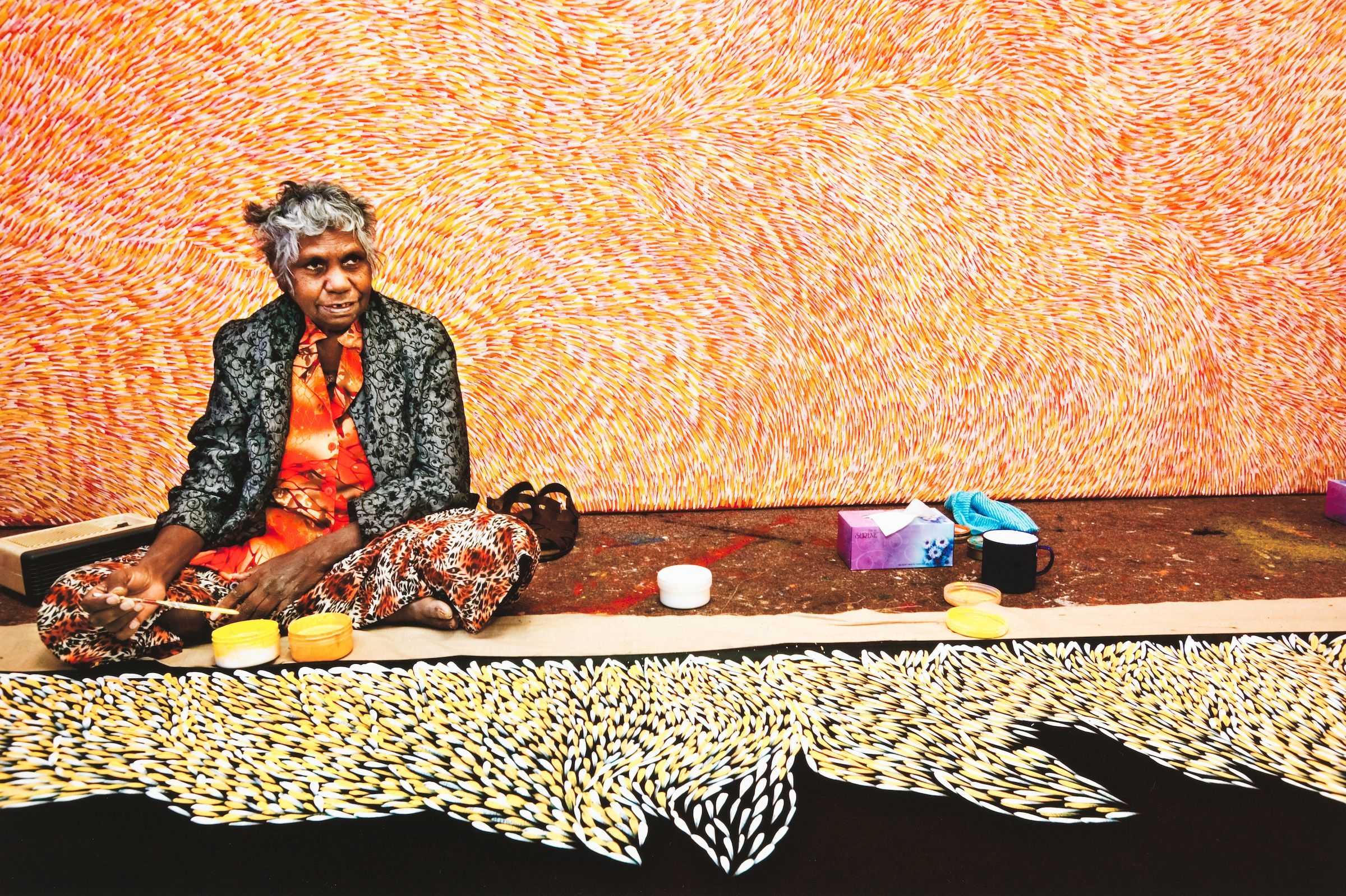Great sadness at the Aboriginal Art Directory with news of the death on 9th June in Mparntwe/Alice Springs of the legendary Anmatyerre artist from Utopia, Gloria Tamerre Petyarre. An incredibly prolific painter, Gloria helped pioneer a whole new attitude towards image making and thinking about Indigenous stories.
I had the good fortune to meet and film her in the 1990s and was transfixed by her charm and mercurial character. Sadly, her massive output of technically superb paintings mitigated against her being taken as seriously as her fellow Anmatyerre artists such as Emily Kngwarrey, her sister Kathleen Petyarre (they were two of seven girls), or even Minnie Pwerle.
Here’s the Art Gallery of NSW’s summation:
“Gloria Petyarre was an experimental artist renowned for her diversity and mastery as a colourist. Her work is anchored in ‘awely’ – a term that not only describes women’s ceremonial body painting but also the wider concept of ‘women’s business’. For example, Petyarre’s major, 21-panel work, ‘Awely for the mountain devil lizard (Twenty-one women)’, 1996, refers simultaneously to ceremonial body painting as sourced in stories relating to Arnkerrth, the mountain devil lizard, and to a larger cosmology that is foundational in Petyarre’s painting. Arnkerrth is a subject of particular importance to Petyarre, and her ability to constantly re-invent its visual representations has been widely recognised”.
In later life, her depiction of the Kurrajong bush medicine leaves with layered, free-flowing, swirling brushstrokes that covered so many canvases became an iconic motif.
Gloria’s career peaked when she won the coveted Wynne Prize for Landscape at the New South Wales Art Gallery in 1999. It was a triumph for Aboriginal art, for Gloria was the first Indigenous Australian artist ever to win a major art prize that wasn’t restricted to First Nations artists.
Gloria continued to paint this style for the next 20 years until her retirement in 2019 due to health problems.
The Utopia artists first became interested in art making when participating in the Utopia Women’s Silk Batik Group in 1977 initiated by CAAMA (the Central Australian Aboriginal Media Association). With up to 80 members, the tremendous success of the Batik project lead to the even more long-lasting ‘Summer Project‘ introduced in 1987 by Rodney Gooch of CAAMA.
This time, the artists painted on small stretched canvases, and many of the women took to the new medium with ease and enthusiasm, with the resulting works exhibited at the S.H.Ervin Gallery in Sydney, and were bought lock, stock and barrel by Robert Holmes a Court.
As demand for Utopia’s art grew, so did Gloria’s career. She travelled with her art to many countries, exhibiting in France, Germany, the United Kingdom, Belgium, the Netherlands, Italy, the USA and Japan. In France, the fashion icon, Hermes seized on her designs to produce a luxury scarf.
Beyond the bush medicine leaves works, Gloria had quite a number of Dreamings in her portfolio…. the ‘Thorny Mountain Devil Lizard Dreaming’, a pattern of swirling coloured lines which imitate the tracks made in the sand by the lizard’s tail; the Yam Dreaming, most associated with her aunt Emily; also the Grass Seed, Pencil Yam, Emu, Bean, Small Brown Grass and Body Paint Dreamings.
Later in her career, Gloria began to paint massive ‘Big Leaf‘ paintings, expressionistic works made with giant brush strokes that mixed colour on the canvas to gain a variety of aesthetic effects.
Apart from her Wynne Prize success, Gloria went on to be a finalist in Sydney another four times. The most prestigious First Nations art competition, the Telstra National Aboriginal and Torres Strait Islander Art Awards featured her artworks on many occasions including its first outing in 1984. In 1994, Utopia Art Sydney gallery gave her her first solo exhibition, but the only institution to follow up was the New England Regional Art Museum in Armidale in 1999. Her works, however, are widely collected.




To whom it may concern,
I have only heard about the sad passing of Gloria Petyarre from the article here on your website.
I have a large painting by Gloria titled, Leafs – Bush Medicine Dreaming. Acrylic on linen.2008 142cm H x 350 cm W
I was wondering how her passing would effect the sale price of her work.
Thank you .
Kind regards
Debra Jackson
Re Debra Jackson’s comment:
Delighted that you bought a mighty work of Gloria’s, and hope that it continues to give you pleasure.
Obviously, there are now a finite number of her paintings on the market, and it’s often the case that an artist’s passing increases the hunger for their works.
But no one can say that that will certainly happen.
Cheers – Jeremy Eccles